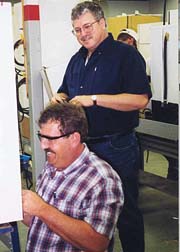
HVAC instructor Bill Matthews is a subscriber to the “more is better” theory, and his commitment to providing a broad range of offerings to his students has helped him earn runner-up status in The News’ third annual HVACR Instructor of the Year contest.
“Employers like it when the students truly understand how to do the job,” he said, pointing to the most important reason for plugging the Linn State program into a wide range of industry training and testing efforts.
Matthews has been in the industry for more than 30 years and an instructor for for 17 years. His classes at LSTC average about 20 students, and they are a mix of 60% theory and 40% hands-on training. He cites the value of an outside advisory committee of industry representatives who meet twice a year to not only see what is being done, but to offer suggestions on new ideas to try. From those meetings came recommendations to incorporate and promote general education classes within the program’s curriculum and implement a 14-week summer semester internship that is now a part of the program’s course of study.
On top of that, students can take part in certification programs offered by North American Technician Excellence (NATE), Refrigeration Service Engineers Society (RSES), the Environmental Protection Agency (EPA), and others.
PARTNERING WITH INDUSTRY
Industry membership is also important, so there are affiliations with RSES, the Council of Air Conditioning and Refrigeration Educators (CARE), and the Air-Conditioning and Refrigeration Institute (ARI) Instructor Workshops. And, students are encouraged to take part in the SkillsUSA/VICA state, regional, and national competitions.Recently, Linn State’s HVAC program became the first in the country to align itself with the Partnership for Air-Conditioning, Heating, Refrigeration Accreditation (PAHRA), a program in which all HVACR programs can assess themselves. PAHRA offers three separate accreditations — residential A/C and heating, light commercial A/C and heating, and commercial refrigeration — and, of course, LSTC received accreditation in all three sections.
“Anytime you’re doing anything like this, you learn about your program. You learn if your program is doing what it is supposed to be doing,” said Matthews.
“It’s a real good feeling,” said Matthews about his school’s involvement in the PAHRA program.
Publication date: 09/09/2002




